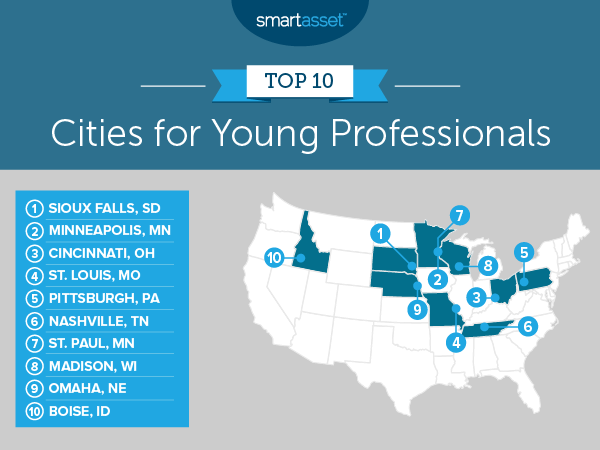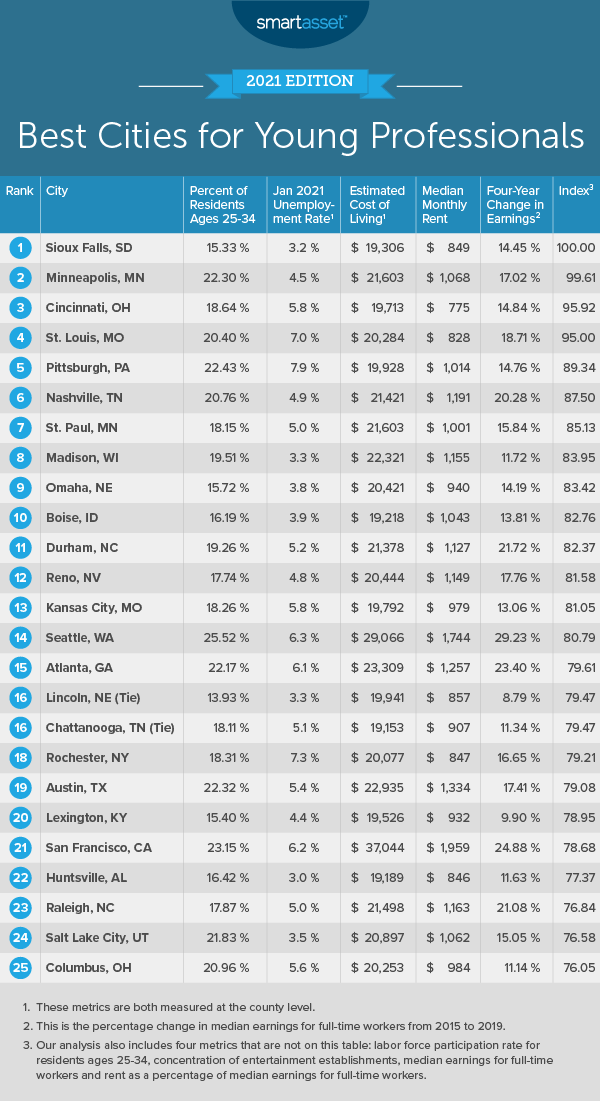Remote work has increased dramatically during the COVID-19 pandemic, offering many young professionals greater flexibility to live farther away from their jobs. But it is unclear whether this employment trend will become permanent. A PricewaterhouseCoopers survey shows that more than two-thirds of executives think that employees should be in the office at least three days a week to maintain a strong company culture. This suggests that while remote work options may be more available in the future, professionals might still need to live near the office. With all this in mind, SmartAsset identified and ranked the best cities where young professionals are living in 2021.
We compared the largest 150 U.S. cities across nine metrics, looking at affordability, workforce demographics and entertainment options. For details on our data sources and how we put all the information together to create our final rankings, check out the Data and Methodology section below.
This is SmartAsset’s fifth annual study on the best cities for young professionals. Check out the 2020 version of the study here.
Key Findings
- Like last year, Midwest cities take the lead. In last year’s edition of our study, seven of the top 10 cities for young professionals were in the Midwest, according to Census regional divisions. Though the same number of Midwest cities rank in the top 10 this year, the cities differ slightly. Overland Park, Kansas and Lexington, Kentucky dropped out of the rankings this year while both St. Paul, Minnesota and Madison, Wisconsin made it into our top 10.
- Young professionals can find affordable rent in the top-ranking cities. Experts say that it is best to spend no more than 30% of your monthly gross income on housing-related expenses. Across the top 10 cities in our study, rent averages only 24% of pre-tax income for full-time workers. In fact, in Cincinnati, Ohio, the median rent makes up just 19.81% of the median full-time earnings.

1. Sioux Falls, SD
Sioux Falls, South Dakota ranks in the top 20 cities for six of the nine metrics we considered. It has the second-lowest January 2021 unemployment rate (3.2%) and the second-highest labor force participation rate among residents ages 25 to 34 (92.6%). The city is also very affordable, ranking 19th-best for its median monthly rent ($849) and 12th-best for the estimated annual cost of living (about $19,300). Finally, it has the seventh-highest concentration of entertainment establishments (2.92%) and the fifth-lowest median rent as a percentage of full-time workers’ earnings (22.33%).
2. Minneapolis, MN
Minneapolis, Minnesota ranks in the top 15 cities for four of the nine metrics in our study. It has the 15th-lowest January 2021 unemployment rate (4.5%) and rent makes up only 22.70% of full-time workers’ earnings. Additionally, many young people live in the city and are part of the labor force. Minneapolis has the 11th-highest percentage of the population between ages 25 and 34 (22.30%) and the 12th-highest labor force participation rate for young professionals (90.5%).
3. Cincinnati, OH
Cincinnati, Ohio is a very affordable city for young professionals looking to save. The estimated annual cost of living in the area is about $19,700, the 23rd-lowest in our study. Additionally, median monthly rent in the city is the fifth-lowest ($775) and it makes up less than 20% of median earnings for full-time workers. Almost 19% of residents in Cincinnati are between the ages of 25 and 34.
4. St. Louis, MO
Like Cincinnati, Missouri’s St. Louis ranks particularly well on metrics that measure affordability. St. Louis has the ninth-lowest median monthly rent ($828) and the 43rd-lowest estimated cost of living (about $20,300). Additionally, earnings for full-time workers in St. Louis have risen over the past several years. From 2015 to 2019, median earnings for full-time workers increased by almost 19%, the 22nd-largest increase across all 150 cities.
5. Pittsburgh, PA
More than 22% of the population in Pittsburgh, Pennsylvania is between ages 25 and 34, the highest rate in our top 10 cities and ninth-highest overall. Median earnings for full-time workers in Pittsburgh are more than $51,300. With median monthly rent at about $1,000, most workers will spend less than 24% of their pre-tax earnings on housing.
6. Nashville, TN
Nashville, Tennessee has a lot to offer young professionals with roughly 21% of the population falling between the ages of 25 and 34. On the county level, entertainment establishments make up almost one in 20 of all establishments, the highest rate in our top 10 and sixth-highest overall. Moreover, average earnings are on the rise. From 2015 to 2019, median earnings for full-time workers in Nashville increased by 20.28%, the 17th-highest change for this metric in our study.
7. St. Paul, MN
St. Paul, Minnesota ranks as the No. 7 city for young professionals, moving up from No. 13 last year. Across the nine metrics our study, St. Paul ranks particularly well for its relatively low January 2021 unemployment rate of 5.0% and the relatively high concentration of entertainment establishments. Specifically, entertainment establishments make up 2.04% of all businesses in the area.
8. Madison, WI
Madison, Wisconsin has the highest labor force participation rate for young professionals in our study, at 93.5%. The median earnings for full-time workers in the city are about $51,300, the 36th-highest out of 150. Madison also has the 16th-highest density of arts, entertainment and recreation businesses, making up 2.34% of all businesses. This city, however, falls farthest behind to the bottom third of our list with an estimated annual cost of living of over $22,300.
9. Omaha, NE
Omaha, Nebraska ranks in the top 30 cities for three metrics: January 2021 unemployment rate (3.8%), entertainment establishment density (1.87%) and median rent as a percentage of full-time workers’ earnings (23.85%). Census Bureau data also shows that across the 150 cities in our study, Omaha has the 41st-lowest median monthly rent, at $940. Median earnings for full-time workers there are the 56th-highest overall, at about $47,300.
10. Boise, ID
Boise, Idaho rounds out our list of the 10 best cities for young professionals. It ranks in the top 10 cities for two metrics: January 2021 unemployment rate (3.9%) and estimated cost of living (about $19,200). Rent in the city is also relatively affordable, with a median monthly rent of $1,043, the 56th-lowest overall. Full-time workers in Boise earn about $48,300 on average, which means that less than 26% of their pre-tax earnings is spent on rent.

Data and Methodology
To rank the best cities for young professionals we looked at data for the 150 largest cities in the U.S. Specifically, we compared cities across the following nine metrics:
- Percentage of the population between ages 25 and 34. Data comes from the Census Bureau’s 2019 1-year American Community Survey.
- January 2021 unemployment rate. Data comes from the Bureau of Labor Statistics and is at the county level.
- Labor force participation rate for young professionals. This is the labor force participation rate for residents ages 25 and 34. Data comes from the Census Bureau’s 2019 1-year American Community Survey.
- Median gross rent. Data comes from the Census Bureau’s 2019 1-year American Community Survey.
- Estimated cost of living. Data comes from the MIT Cost of Living calculator and is measured at the county level.
- Entertainment establishment density. This is the percentage of all establishments in the area dedicated to arts, entertainment or recreation. Data comes from the Census Bureau’s 2018 County Business Patterns Survey.
- Median earnings for full-time workers. Data comes from the Census Bureau’s 2019 1-year American Community Survey.
- Four-year change in median earnings. This is the percentage change in median earnings for full-time workers from 2015 to 2019. Data comes from the Census Bureau’s 2015 and 2019 1-year American Community Surveys.
- Median rent as a percentage of full-time workers’ earnings. Data comes from the Census Bureau’s 2019 1-year American Community Survey.
First, we ranked each city in every metric, weighting all metrics equally. Then we found each city’s average ranking and used the average to determine a final score. The city with the best average ranking received a score of 100. The city with the lowest average ranking received a score of 0.
Tips for Deciding Where to Live?
- Decide whether to buy or rent. Even if you have the savings to buy a first home, be sure the switch makes sense. If you are coming to a city and plan to stay for the long haul, buying may be the better option for you. Additionally, a home may offer more space for people who do regularly work from home. However, if your stop in a new city will be a short one, renting may make the most sense. SmartAsset’s rent vs. buy calculator can help you see the cost differential between purchasing a home or apartment and renting.
- See if you can handle the mortgage. It is important to know what you’ll pay each month and for how long before you buy a home. To get a sense of what that might look like, check out SmartAsset’s free mortgage calculator.
- Seek out trusted advice. No matter where you live, a financial advisor can help you get your financial life in order. Finding the right financial advisor who fits your needs doesn’t have to be hard. SmartAsset’s free tool matches you with financial advisors in your area in five minutes. If you’re ready to be matched with local advisors that will help you achieve your financial goals, get started now.
Questions about our study? Contact us at press@smartasset.com.
Photo credit: ©iStock.com/DenisTangneyJr
